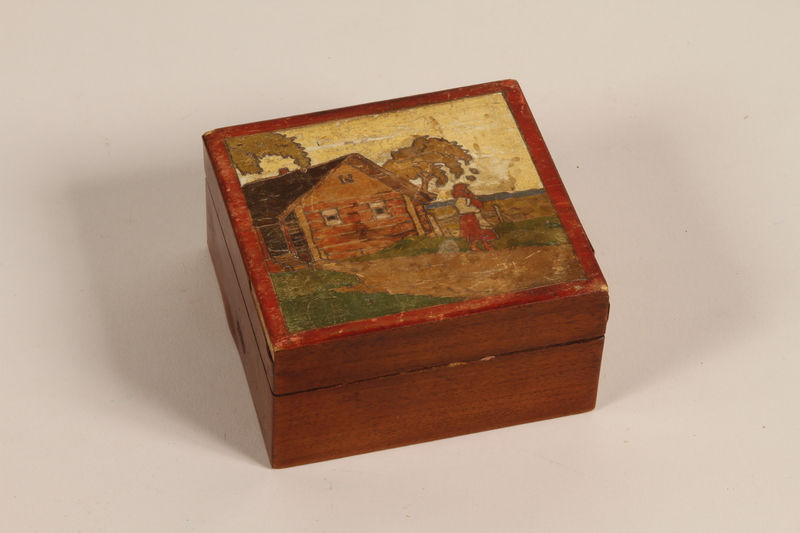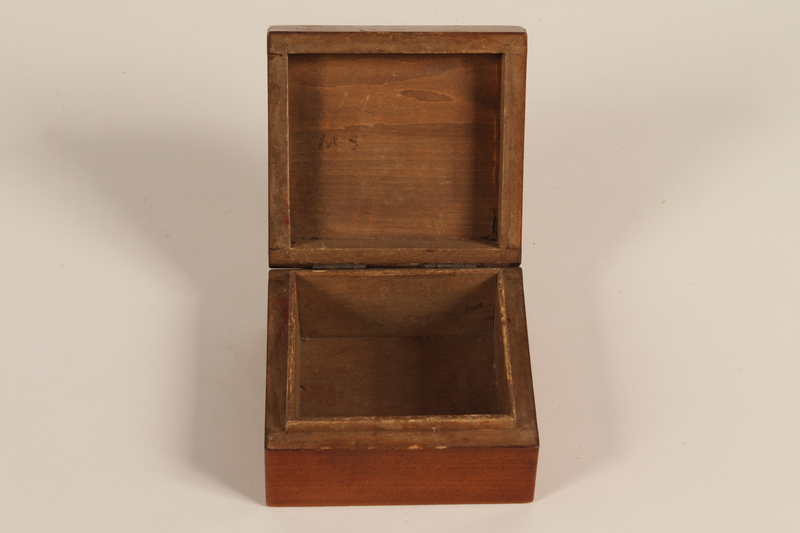Overview
- Brief Narrative
- Decorative box kept by 17 year old Hanni Sondheimer as a souvenir of Lithuania when she and her family fled that country in February 1941. Hanni, her parents, Moritz and Setty, and her 14 year old brother, Karl, fled Kaunas due to the Soviet occupation in 1940. They planned to emigrate to the United States, but visa restrictions made them take a difficult route through Russia to Japan. Classified as stateless refugees when they reached Japan in March 1941, they were deported to Shanghai where they survived the war in the Hongkew ghetto. Hanni married a US soldier and emigrated to the United States in 1946. Her family emigrated the next year.
- Date
-
received:
approximately 1938
emigration: 1941 February
- Geography
-
received:
Kaunas (Lithuania)
en route: Hongkou Qu (Shanghai, China)
- Credit Line
- United States Holocaust Memorial Museum Collection, Gift of the Estate of Hanni Vogelweid
- Contributor
-
Subject:
Hanni Vogelweid
- Biography
-
Hanni Lori Sondheimer was born on October 5, 1923, in Berlin, Germany. Her father, Moritz, was born on August 27, 1894 in Schluchtern, Germany, to Malchen Bergman Sondheimer, born in the 1860s. He had two sisters, Liesl and Herta. Her mother, Setty Polver, was born on October 28, 1897, in Hassfurt, Germany, and she had four sisters, Selma, Paula, Greta, and Sofie and two brothers, Hugo and Justin. Hanni had a younger brother, Karl, born on January 17, 1926. They were an observant Jewish family. Moritz owned a leather goods store. After Hitler came to power in 1933, the Nazi government sanctioned anti-Jewish boycotts and enacted anti-Jewish legislation that led Moritz decide to move his family to Kaunas (Kovno), Lithuania, in 1934. He opened a small factory, Kasufa, which manufactured plastic combs and buttons as well as shoes and socks. He offered work to many Polish Jewish refugees who fled Poland due to anti-Semitism and the encroaching Nazi Reich. Hanni attended a German school, until her German classmates became openly anti-Semitic and many began wearing swastikas. She transferred to an ORT school, a Jewish vocational school, to learn millinery skills and had tutors to learn Hebrew. The family studied English, but they spoke German at home. Many of Moritz’s relatives fled Germany for Estonia in the 1930s; Setty’s siblings emigrated to the United States.
After the Soviets occupied Lithuania in the summer of 1940, they nationalized Moritz's business and the family’s bank accounts. Moritz was fired because one of his secretary’s told the Russians that he tried to steal money. He later was able to get a job as a worker at his former factory. Two Russian soldiers were boarded with the family. Moritz went to the consulate to renew the family’s German passports in July 1940. He hoped their German citizenship would allow them some protection as they prepared to leave the country. Setty wrote to her sister and brothers in the United States for affidavits of support for US visas. Without visas, the family would be trapped in Soviet territory. Hanni’s paternal relatives in Estonia were deported by the Soviets to a labor camp in Karaganda, Kazakhstan. Hanni was sent to get visas from the Dutch and Japanese consuls as the eastward route through the Soviet Union seemed the only way to escape. The family obtained Dutch visas on July 29, 1940, for Curacao in the Netherlands Antilles signed by Jan Zwartendijk and Japanese transit visas on August 6, 1940, from Chiune Sugihara. Soviet exit visas were extremely hard to obtain and the family had to go for an interview with the NKVD, the Soviet secret police. Their relatives in the US had to send $800 to Intourist, the Soviet government travel agency. Once they had all their permits, they sold their household possessions for ready cash. As the family was about to leave in February 1941, Setty became ill. The family considered delaying the trip, but Dr. Elkes advised her to leave while they could. Since their Russian rubles were only of value in the USSR, they booked first class passage on the Trans-Siberian railroad. They carried only one bag each, plus a couple of shared duffel bags. Hanni was able to bring some of her favorite things, her ice skates, her red shoes, and a picture of the actor Gary Cooper. When Hanni told a Soviet train engineer that they planned to go to the US, he told her that it was pointless, as the Soviets empire would eventually reach there. The border search at the Soviet port in Vladivostok was very thorough. The Soviet guards searched orthodox women’s wigs and confiscated nearly all belongings in the name of the war effort.
They boarded ship and arrived in Tsuruga, Japan, in March 1941. Her father had obtained and hidden $40 in American currency before they left Kaunus, which kept them fed for a while. They went to Kobe, but were told by JEWCOM, the Jewish Community Council, that refugee aid in that city was only for Polish Jews; German Jews must go to Yokahama. The affidavits of support from their relatives in the US finally arrived. They went for an interview at the US consulate but were not granted visas because they still had relatives in Europe. They did obtain Ecuadorian visas, but by then immigration was not possible because of Japanese travel restrictions for the Pacific. Japanese authorities considered the family stateless and they were deported to Japanese occupied Shanghai, China, in September 1941. They lived in one room and had to sell their remaining belongings for food. In early 1943, they were relocated to the Hongkew ghetto where conditions were even worse. Moritz found work with a Russian Jewish stove maker and wool importer, supervising Chinese laborers as they unloaded ships. Hanni and her brother, Karl, worked in a textile factory; Karl was a weaver and Hanni worked with the spools of material. She learned some Chinese and tried to make money selling ties on the street and teaching German to ghetto residents.
On September 3, 1945, Shanghai was liberated by American forces. Aid packages started to arrive and Hanni’s maternal aunt Selma in Los Angeles sent food and Revlon nail polish. Hanni got a job working on the US army base. She married a US Army Lieutenant Al Gade, in September 1946 and sailed with him for Comanche, Iowa. Her parents and brother emigrated to Los Angeles in 1947. Moritz’s mother and his sister’s families were released from the labor camp in Kazakhstan and he brought his mother and a grandson to Los Angeles in 1947. Hanni had one child and divorced in 1952. Her mother died in 1996, age 99 years. Hanni married Lloyd Vogelweid in California. Hanni died on January 27, 2006, age 83 years.
Physical Details
- Classification
-
Containers
- Category
-
Boxes
- Object Type
-
Painted wooden boxes (lcsh)
- Physical Description
- Square lacquered wooden box with a double hinged lid. On the top is a carved, multi-colored painted image of a house with a woman wearing a red skirt walking on a path. The lid interior has numbers and illegible text. The box forms a set with 2007.101.5.
- Dimensions
- overall: Height: 2.125 inches (5.398 cm) | Width: 4.250 inches (10.795 cm) | Depth: 4.000 inches (10.16 cm)
- Materials
- overall : wood, veneer, lacquer, paint, metal
- Inscription
- inside lid : 1 x 5
underside : illegible letters
Rights & Restrictions
- Conditions on Access
- No restrictions on access
- Conditions on Use
- No restrictions on use
Keywords & Subjects
Administrative Notes
- Legal Status
- Permanent Collection
- Provenance
- The box was donated to the United States Holocaust Memorial Museum in 2007 by Lloyd Vogelweid, the widower of Hanni Vogelweid, on behalf of the Estate of Hanni Vogelweid.
- Record last modified:
- 2022-07-28 18:29:06
- This page:
- https://collections.ushmm.org/search/catalog/irn518992
Also in Hanni Sondheimer Vogelweid family collection
The collection consists of artifacts, documents, and publications relating to the experiences of Hanni Sondheimer, her parents, Moritz and Setty, and her brother, Karl, as they emigrated from Berlin, Germany, to Kaunas, Lithuania, and then to Shanghai, China, before and during the Second World War. Some of these materials may be combined into a single collection in the future.
Date: 1930-1947
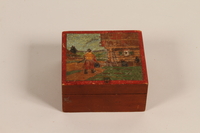
Wooden box with a painted Lithuanian folk scene with man given to a German Jewish refugee
Object
Decorative box kept by 17 year old Hanni Sondheimer as a souvenir of Lithuania when she and her family fled that country in February 1941. Hanni, her parents, Moritz and Setty, and her 14 year old brother, Karl, fled Kaunas due to the Soviet occupation in 1940. They planned to emigrate to the United States, but visa restrictions made them take a difficult route through Russia to Japan. Classified as stateless refugees when they reached Japan in March 1941, they were deported to Shanghai where they survived the war in the Hongkew ghetto. Hanni married a US soldier and emigrated to the United States in 1946. Her family emigrated the next year.
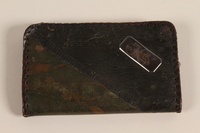
Monogrammed black and tan laced leather wallet used by a German Jewish refugee
Object
Leather billfold received by 17 year old Hanni Sondheimer when she and her family fled Kaunas, Lithuania, in February 1941. It has a scene of Kaunas on the front and was given to her by a friend shortly before her departure. Hanni, her parents, Moritz and Setty, and her 14 year old brother, Karl, fled Kaunas due to the Soviet occupation in 1940. They planned to emigrate to the United States, but visa restrictions made them take a difficult route through Russia to Japan. Classified as stateless refugees when they reached Japan in March 1941, they were deported to Shanghai where they survived the war in the Hongkew ghetto. Hanni married a US soldier and emigrated to the United States in 1946. Her family emigrated the next year.
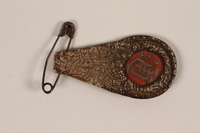
Red enamel permit tag in leather holder issued to a German Jewish refugee
Object
Metal and leather identification tag issued to Moritz Sondheimer when he lived in the Hongkew ghetto in Shanghai, China, from 1941-1945. The tag permitted the bearer to leave the ghetto for work and was color coded to denote the term of valid use. The pass would also include an identification photograph. Moritz, his wife, Setty, and their children, 17 year old Hanni and 14 year old Karl fled Kaunas, Lithuania, in February 1941 following the Soviet occupation in 1940. They planned to emigrate to the United States, but visa restrictions made them take a difficult route through Russia to Japan. Classified as stateless refugees when they reached Japan in March 1941, they were deported to Shanghai where they survived the war in the Hongkew ghetto. Hanni married a US soldier and emigrated to the United States in 1946. Her family emigrated the next year.
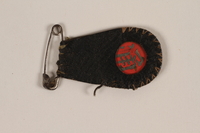
Red enamel permit tag in leather holder issued to a German Jewish refugee
Object
Metal and leather identification tag issued to 17 year old Hanni Sondheimer when she lived in the Hongkew ghetto in Shanghai, China, from 1941-1945. The tag permitted the bearer to leave the ghetto for work and was color coded to denote the term of valid use. The pass would also include an identification photograph. Hanni, her parents, Moritz and Setty, and her 14 year old brother, Karl, fled Kaunas, Lithuania, in February 1941 following the Soviet occupation in 1940. They planned to emigrate to the United States, but visa restrictions made them take a difficult route through Russia to Japan. Classified as stateless refugees when they reached Japan in March 1941, they were deported to Shanghai where they survived the war in the Hongkew ghetto. Hanni married a US soldier and emigrated to the United States in 1946. Her family emigrated the next year.
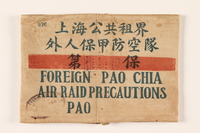
Pao Chia red striped armband worn by a German Jewish refugee
Object
Armband issued to Moritz Sondheimer by the Japanese occupation authorities of the Hongkew ghetto in Shanghai where he lived from 1941-1945. Moritz was required to serve in Pao Chia, a civil and ghetto defense force composed of foreign and Chinese males, aged 20 to 45. Moritz, his wife, Setty, and their children, 17 year old Hanni and 14 year old Karl fled Kaunas, Lithuania, in February 1941 following the Soviet occupation in 1940. They planned to emigrate to the United States, but visa restrictions made them take a difficult route through Russia to Japan. Classified as stateless refugees when they reached Japan in March 1941, they were deported to Shanghai, China, where they survived the war in the Hongkew ghetto. Hanni married a US soldier and emigrated to the United States in 1946. Her family emigrated the next year.
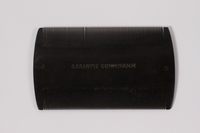
Stamped black plastic dust comb owned by a German Jewish refugee
Object
Lice comb kept by 17 year old Hanni Sondheimer when she and her family fled in February 1941. The comb was made at the plastics factory owned by her father in Kaunas. Hanni, her parents, Moritz and Setty, and her 14 year old brother, Karl, fled Kaunas, Lithuania, due to the Soviet occupation in 1940. They planned to emigrate to the United States, but visa restrictions made them take a difficult route through Russia to Japan. Classified as stateless refugees when they reached Japan in March 1941, they were deported to Shanghai where they survived the war in the Hongkew ghetto. Hanni married a US soldier and emigrated to the United States in 1946. Her family emigrated the next year.
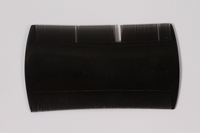
Black plastic dust comb owned by a German Jewish refugee
Object
Lice comb kept by 17 year old Hanni Sondheimer when she and her family fled in February 1941. The comb was made at the plastics factory owned by her father in Kaunas. Hanni, her parents, Moritz and Setty, and her 14 year old brother, Karl, fled Kaunas, Lithuania, due to the Soviet occupation in 1940. They planned to emigrate to the United States, but visa restrictions made them take a difficult route through Russia to Japan. Classified as stateless refugees when they reached Japan in March 1941, they were deported to Shanghai where they survived the war in the Hongkew ghetto. Hanni married a US soldier and emigrated to the United States in 1946. Her family emigrated the next year.
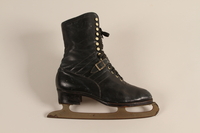
Pair of black leather lace-up ice skates owned by a German Jewish refugee
Object
Pair of ice skates kept by 17 year old Hanni Sondheimer when she and her family fled Lithuania in February 1941. "I couldn't bring much, and I loved ice skating and I could take my ice skates because I thought in America you can ice skate." Hanni, her parents, Moritz and Setty, and her 14 year old brother, Karl, fled Kaunas due to the Soviet occupation in 1940. They planned to emigrate to the United States, but visa restrictions made them take a difficult route through Russia to Japan. Classified as stateless refugees when they reached Japan in March 1941, they were deported to Shanghai where they survived the war in the Hongkew ghetto. Hanni married a US soldier and emigrated to the United States in 1946. Her family emigrated the next year. following the Soviet occupation in 1940. They planned to emigrate to the United States, but quota restrictions made them take a difficult route through Russia to Japan. Classified as stateless refugees when they reached Japan in March 1941, they were deported to Shanghai, China, where they survived the war in the Hongkew ghetto. Hanni married a US soldier and emigrated to the United States in 1946. Her family emigrated the next year.
Estate of Hanni Vogelweid papers
Document
Documents illustrating the experiences of the Sondheimer family who emigrated from Berlin, Germany in 1934 to Kovno, Lithuania and then were forced to flee through Eastern Europe eventually being interned in a ghetto in Shanghai, China, where they remained throughout the Second World War. The collection represents Moritz Sondheimer, his wife Setty and their daughter Hanni; dated 1930's and 1940's; in Lithuanian, German, Chinese and English.
Book
Object
Book titled, "Englisch als erste fremdsprache- Teil 3" with exercises and stories to learn English.
Book
Object
Book titled, "Daily Prayer with English Directions" revised and arranged by A. Hyman; Hebrew, English; 1916
Book
Object
Book titled, "Union Hymnal for Jewish Worship" with music and words for services; English, Hebrew; 1914
Hanni Vogelweid papers
Document
Contains a marriage certificate and affidavit for Hanni Lore Sondheimer and Alfred Gade, both dated 1946, issued in Shanghai, China; photographs (38) depicting Shanghai, China with images taken on Hanni and Alfred's wedding day as well as street scenes of Shanghail; two full pages from a newspaper entitled "Suchrubruik aus Shanghai," listing advertisements placed by members of the Shanghai Jewish community listing members of their families for whom they are searching, dated circa 1945 or 1946.
Sondheimer family papers
Document
Contains two German passports (Deutsches Reich Reisepass) belonging to donor's parents, Moritz and Setty Sondheimer; donor's brother Karl's identification is included in Moritz's passport, which documents the family's flight from Nazi occupation through Lithuania, Russia, and Japan, and eventually to Shanghai, China where they remained until after the second World War ended. Includes red letter "J" added on date of passport's issue, July 5, 1940, in Kaunas (Kovno), Lithuania, and Moritz's passport includes as his middle name "Israel."

